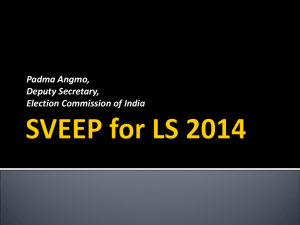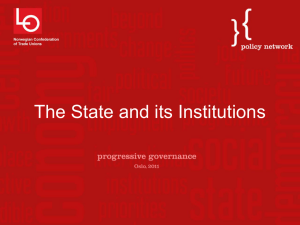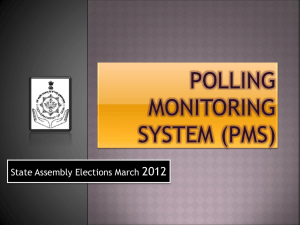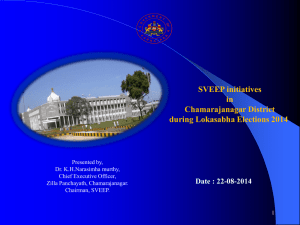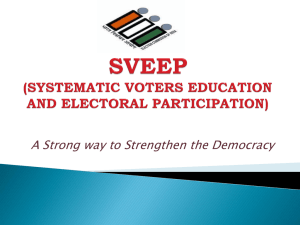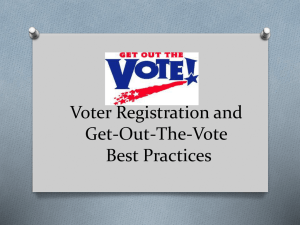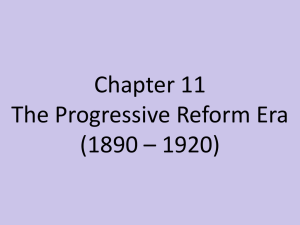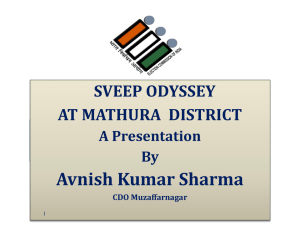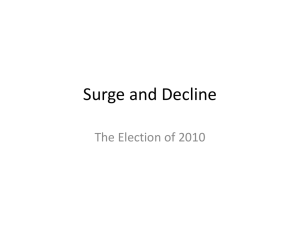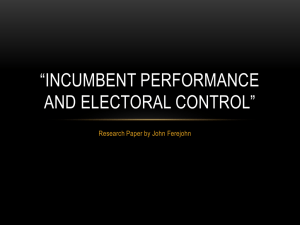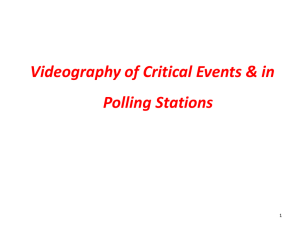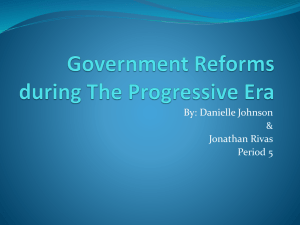Ms Palka Sahni, DEO, Nalanda
advertisement
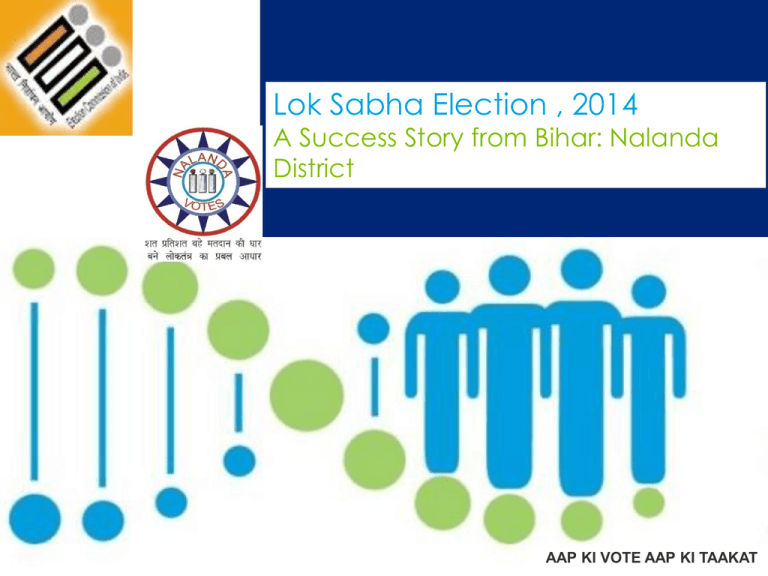
Lok Sabha Election , 2014 A Success Story from Bihar: Nalanda District AAP KI VOTE AAP KI TAAKAT BACKGROUND 2 Background • Lok Sabha Elections, 2014, landmark shift in ECI approach with emphasis on participative elections. • Nalanda : A paradox • Earliest seat of wisdom and learning with international acclaim • Only 1 out of every 3 eligible voters in the district exercised their franchise in the LS- 2009. • One of the lowest VTR in the country 33% • Female participation 29% • Based on broad framework of ECI SVEEP strategy, customised and improvised at District level 3 CHALLENGES 4 Key Challenges • Stakeholder Analysis: • (a) Urban apathy, (b) Rural apathy (c) Female apathy. − Lack of awareness about importance of voting − Lack of knowledge about electoral procedures − Unwelcoming booth ambience − Lack of enthusiasm in the youth − Migrant population − Curfew –Like situation on poll day • SWOT analysis –Bleak past legacy of low voter turnout • Conversion of the weaknesses into strength and threats into opportunities • Adoption of multi-pronged long drawn strategy over two months 5 STRATEGY 6 Multi Pronged Strategy 7 IMPLEMENTATION 8 Implementation Public Communication • Election logo “Nalanda Votes” with a quote “Aap ki Vote Aap ki Taakat” was designed and was used in all official letters as a means for public communication • Effective use of mass media • Strategic selection of locations such as railways stations, Bank, Post Office, Bus Stand, Market Centres , Rural Haats • Use of Hoardings and wall paintings carrying slogans in local dialect used to encourage voters to exercise their right to vote. • Date of Poll emphasised 9 Implementation Public Communication • Door- to- Door movement of ‘Preraks’ of National Literacy Mission and civil society groups across rural & urban areas • Special promotion activities on National Voters Day, Bihar Diwas, Women’s Day & festive occasions such as Holika Dahan • State Icons impact invited for maximum • Publicity through print & electronic media, local cable TV channels, radio stations and cinema halls 10 Implementation Public Communication • Cartoons and posters for effective communication • Regular Press Briefings and media interactions • Leading by Example • Casting of votes by all important district officials on the voting day helped in sending positive message to the public 11 Implementation Public Communication - Cartoons 12 Implementation Public Communication – Rallies, Door to Door Activities & Hoardings 13 Implementation Gender, Urban & Youth Participation • International Women’s Day was leveraged to urge female voters to vote • Women were mobilized from households in minority dominated areas • Anganwadi Sewikas, Asha workers, Sakshar Bharat Preraks) participated in spreading awareness through rallies & street plays across urban & rural areas 14 Implementation Women, Urban & Youth Participation • Women were involved and sensitized through house to house contacts, melas and street plays • Special voter registration drives & issue of Election Photo Identity Cards (EPIC) were conducted for female voters. • District Icon • Head SVEEP Committee • State Icon 15 Implementation Gender, Urban & Youth Participation • Demonstrated power of vote through street plays, human chains, cycle races, processions etc. to overcome urban apathy • Campaigns shopkeepers/vendors signing of ‘Sankalp Patras’ for through • Awareness activities at places of heavy footfall including bus stands, railway stations etc. • Special voter registration drives & issue of Election Photo Identity Cards (EPIC) for urban voters • Active participation of campus ambassadors. girls as 16 Implementation Women, Urban & Youth Participation • Various events were organised such as quiz, debates, singing competition, cycle race across colleges to spread the message of election & voting • Interaction with Rural Voters at Schools, Rangoli Activity, etc. were undertaken to generate awareness • Active participation of school girls : • Private and Government 17 Implementation Voter Education & Awareness • Nukkad-Natak at ChowkChaouraha/ Anganbari Centers were organized • Special events were held such as forming human chains with candles, oath taking for ethical voting at public gatherings, cycle rallies etc. in order to motivate voters • Cultural programmes & similar events were organised to spread the message of election as a festival 18 Implementation Voter Education & Awareness, contd. • Awareness was spread through school going children to their parents/family for participation in the election through Sankalp Patras 19 Implementation Voter Facilitation • Special Registration drives for left out voters • 17 lakhs(85%) Photo Voter slips were distributed ahead of poll day through BLO • 257 model polling stations • Call centre to help voters in searching their names in voter list andidentifying their polling station. • Multiple visits to polling booths with lowest VTR in LS 2009 • Android based Basic Minimum Facility mapping 20 Implementation Voter Facilitation • Polling booths were decorated with festoons & colored papers so as to create a festive mood and not a curfew like situation • Provision of drinking water, sheds, toilets for women, ramp, first aid for physically disabled & old persons across all polling booths were made • Proper law and order arrangements inside polling booths was ensured including management of queues & voter friendly environment 21 Implementation Training & Capacity Building • Training of trainers was organized for presiding officers for a hassle free voting experience on polling day • Trainings were imparted to all the booth level officers, sensitizing them on the important issues relating to roll revision • Electors were trained about the NOTA facility in the ballot unit • Self-help groups members were trained through meetings / training session for conducting awareness campaigns across communities in remote locations • EVM demonstration and hands-on training was imparted particularly in the rural and remote areas 22 Implementation Technology & Social Media • Awareness activities were undertaken through social media platforms like facebook in order to proactively engage youth voters • Polling date reminders and polling station details were sent through SMS • Mobile based technologies like IVRS, Caller Tunes etc. were used for awareness creation • Polling station locations search facility was provided through GIS/Google map • District website was used to receive queries/complaints from voters 23 Implementation Collaboration • Information and Public Relations Department, Education Department AIR, Doordarshan, local cable operators were made partners in this endeavour • Self Help Groups: leveraging their reach • Tie ups were made with anganwadi centers, railway stations, ATM counters, Sudha milk counters, banks buildings for IEC display 24 Implementation Monitoring & Evaluation • Formation of District and block level SVEEP Core Committees • Strict adherence to carefully drafted timelines • Control chart with mobile numbers, name and designation of the relevant functionaries were prepared to ensure effective monitoring • Multiple visits to poorest turnout booths on the lines of RI • Regular video conferencing, meetings to ensure proper communication and progress evaluation of partners and field functionaries, • Evaluation and documentation of every field reports/activities were undertaken at the requisite level 25 IMPACT 26 OUTCOMES 20 13% growth • 62% growth in no. of votes cast at polling stations 19.5 − Significant increase in increase in Female voters - 79% • Voters turnout improved from 33.1% in 2009 to 47.3% in 2014 − Significant improvement in Female voters turnout - from 29.1% in 2009 to 45.8% in 2014 − Male voters turnout improved from 36.5% in 2009 to 48.6% in 2014 • 13% growth in Registered voters 17.2 Nos. in lakhs − 50% increase in Male voters 15 62% growth 10 9.22 5 5.69 Turnout 33.1% Turnout 47.3% 0 2009 Registered voters 2014 Votes cast 27 THANK YOU Thank You Thank you 28
